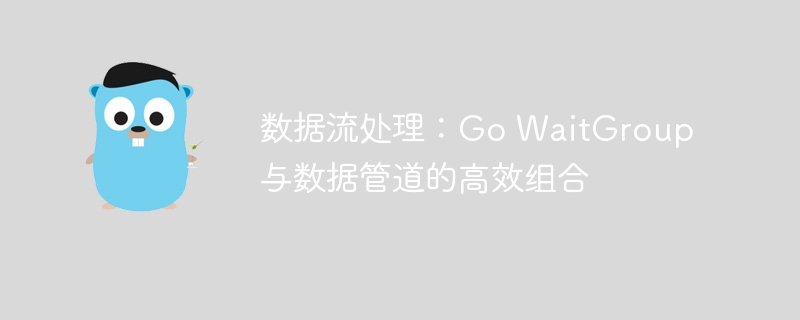

Data flow processing: Efficient combination of Go WaitGroup and data pipeline
Abstract:
In modern computer application development, data flow processing is a common task. It involves processing large amounts of data and is required to be completed in the shortest possible time. As an efficient concurrent programming language, Go language provides some powerful tools to handle data flows. Among them, WaitGroup and data pipeline are two commonly used modules. This article will introduce how to use the efficient combination of WaitGroup and data pipeline to process data flow, and give specific code examples.
1. What is WaitGroup?
WaitGroup is a structure in the Go language standard library, used to wait for a group of concurrent tasks to complete. We can add the number of tasks that need to be waited for through the Add() method, then indicate the completion of a certain task through the Done() method, and finally wait for all tasks to be completed through the Wait() method. Using a WaitGroup ensures that the program does not exit before all tasks are completed.
2. What is a data pipeline?
The data pipeline is actually a FIFO (first in, first out) queue used to transfer data between concurrent tasks. It can be thought of as a pipe for sharing data through communication. In Go language, we can use channel types to define data pipelines.
3. Why do we need to combine WaitGroup and data pipeline?
Combining WaitGroup and data pipeline can achieve efficient data flow processing. When we have a set of parallel tasks to process, we can use WaitGroup to wait for all tasks to complete. The data pipeline provides an ordered and thread-safe data transfer mechanism. By reasonably combining the two, we can achieve efficient data processing processes.
4. Code Example
The following is a simple code example that shows how to combine WaitGroup and data pipeline to process data flow.
package main
import (
"fmt"
"sync"
)
func worker(id int, jobs <-chan int, results chan<- int, wg *sync.WaitGroup) {
defer wg.Done()
for j := range jobs {
fmt.Printf("Worker %d started job %d
", id, j)
// 模拟任务处理过程
for i := 0; i < j; i++ {
// do something
}
fmt.Printf("Worker %d finished job %d
", id, j)
results <- j // 将处理结果发送到结果通道
}
}
func main() {
jobs := make(chan int, 100) // 创建任务通道
results := make(chan int, 100) // 创建结果通道
var wg sync.WaitGroup // 创建WaitGroup
numWorkers := 5 // 并行工作者数量
// 添加任务到通道
for i := 1; i <= 10; i++ {
jobs <- i
}
close(jobs)
// 启动并行工作者
wg.Add(numWorkers)
for i := 0; i < numWorkers; i++ {
go worker(i, jobs, results, &wg)
}
// 等待所有任务完成
wg.Wait()
close(results)
// 打印结果
for r := range results {
fmt.Printf("Job %d completed
", r)
}
}In the above example, we simulated a data processing process with 5 parallel workers. The main function first creates a task channel and a result channel, and then adds 10 tasks to the task channel. Next, we use WaitGroup and for loop to start parallel workers. Each worker receives a task from the task channel and processes it. After processing is completed, the worker sends the results to the result channel and signals completion of the task through the Done() method. Finally, we use a range loop to read the results from the result channel and print them out.
By combining WaitGroup and data pipelines, we can achieve efficient concurrent data processing. In actual applications, we can adjust the number of concurrent workers and tasks according to the actual situation to achieve the best processing performance.
Summary:
This article introduces how to use WaitGroup and data pipeline in Go language to achieve efficient data flow processing. By combining these two tools, we can achieve thread-safety in waiting for concurrent tasks and data transmission. Through concrete code examples, we show how to use these two tools to process data flows. I hope this article can help readers better understand how to use WaitGroup and data pipelines to improve the efficiency of data processing.
The above is the detailed content of Data flow processing: efficient combination of Go WaitGroup and data pipeline. For more information, please follow other related articles on the PHP Chinese website!




